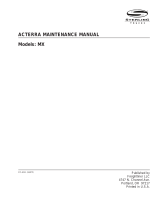Page is loading ...

1
®
SD-03-3652
Bendix
®
TP-3
™
Tractor Protection Valve
FIGURE 1
DESCRIPTION
The TP-3
™
(See Figure 1) tractor protection valve is used in
combination with the PP-3
™
trailer supply valve on pre-121
tractors and the PP-7
™
trailer supply valve on post-121
tractors. It contains a passage for trailer supply air and a
service line shut off valve. It is normally mounted behind the
cab with the delivery line from the trailer supply valve
connected into the tractor emergency port and a delivery
line from the brake valve connected to the tractor service
port. The trailer supply and service hoses are mounted in
their respective ports in the TP-3
™
valve. (See Figure 2)
OPERATION
Air from the trailer supply valve passes through the
emergency ports of the TP-3
™
valve to supply the trailer air
system and simultaneously exerts pressure on the end of
the plunger (3). Figure 3. TP-3
™
valves manufactured prior to
June 1970 required approximately 80 psi on the plunger to
open the inlet valve (4) (See Figure 4) which opens the service
line shut off line. Valves manufactured after June 1970 require
approximately 45 psi to open the inlet valve. (Modification
kit 265066 is available to modify old revision TP-3
™
valves to
the later revision 45 psi opening. Field maintenance kit
280858 contains the parts necessary to service both old
and new).
Whenever the pressure from the trailer supply valve drops
below 45 psi the TP-3
™
valve will close the service line shut-off
valve.
PREVENTIVE MAINTENANCE
Important: Review the Bendix Warranty Policy before
performing any intrusive maintenance procedures. A warranty
may be voided if intrusive maintenance is performed during
the warranty period.
TRACTOR
EMERGENCY
PORT
TRAILER
SERVICE
PORT
TRAILER
EMERGENCY
PORT
TRACTOR
SERVICE
PORT
OLD REVISION TYPE TP-3
™
TRACTOR PROTECTION VALVE
OPENING PRESSURE
APPROXIMATELY 80 PSI
O-RING (7)
RETAINING RING (1)
DIAPHRAGM
SEAT (9)
WASHER (8)
PRELOAD
SPRING (2)
DIAPHRAGM (5)
VALVE SPRING (6)
CAP SCREW (3)
INLET VALVE (4)
O-RING (13)
VALVE (4)
RETAINING
RING (1)
O-RING (7)
SEAT
O-RING (12)
VALVE
RETAINER (10)
PLUNGER (3)
CAP SCREW (3)
WASHER (8)
DIAPHRAGM (5)
DIAPHRAGM
SEAT (9)
SPRING (6)
NEW REVISION TYPE TP-3
™
TRACTOR PROTECTION VALVE
OPENING PRESSURE
APPROXIMATELY 45 PSI
RETAINING
RING (14)
EXTERIOR VIEW

2
FIGURE 2
TRAILER
SERVICE LINE
TRAILER
EMERGENCY
LINE
TP-3
™
TRACTOR
PROTECTION
VALVE
NO. 2
RESERVOIR
BRAKE
VALVE
NO. 1
RESERVOIR
DOUBLE
CHECK
COMPRESSOR
PP-3
™
CONTROL
VALVE
No two vehicles operate under identical conditions; as a
result, maintenance intervals may vary. Experience is a
valuable guide in determining the best maintenance interval
for air brake system components. At a minimum, the TP-3
™
valve should be inspected every 6 months or 1500 operating
hours, whichever comes first, for proper operation. Should
the TP-3
™
valve not meet the elements of the operational
tests noted in this document, further investigation and service
of the valve may be required.
OPERATING AND LEAKAGE CHECKS
1. Block and/or hold the vehicle by a means other than air
brakes during these tests. Place the trailer supply valve
in the emergency position and disconnect the trailer
supply and service couplings.
2. With tractor reservoirs charged to at least 100 psi make
and hold a full service brake application. Leakage at
either tractor hose coupling should not exceed a 1"
bubble in 5 seconds (100 SCCM).
3. Connect the trailer supply or emergency line hose
coupling and place the trailer supply valve in the “run”
position. Leakage at the “service” coupling should not
exceed a 1" bubble in 5 seconds (100 SCCM).
4. Connect the service coupling and make and hold a full
service brake application: Leakage at the diaphragm
end of the TP-3
™
valve shall not exceed a 1" bubble in 3
seconds (175 SCCM).
NOTE: If the TP-3
™
valve does not function as described or
if leakage is excessive, it is recommended that it
be returned to the nearest authorized Bendix parts
outlet for factory rebuilt valve. If this is not possible,
the valve should be repaired using genuine Bendix
parts, in which case the following should prove
helpful.
REMOVING
Remove trailer hose assemblies from the TP-3
™
valve.
Disconnect tractor service and supply lines and remove
the TP-3
™
valve.
INSTALLING
When installing the TP-3
™
valve, refer to Figure 2 for proper
connections along with the following explanation.
1. The delivery line from the trailer supply valve (PP-3
™
or
PP-7
™
) is connected to the tractor emergency port of
the TP-3
™
valve.
2. The delivery line from the brake valve (or double check
valve) is connected to the tractor service port of the TP-3
™
valve.
3. Trailer hose assemblies are installed in the trailer
emergency and trailer service ports of the TP-3
™
valve.
TC-2
™
CONTROL VALVE

3
DISASSEMBLY
EARLY REVISION 80 PSI OPENING PRESSURE
(Figure 1)
1. Remove insert retainer ring (1) Figure 4 with Truarc pliers.
2. Remove insert assembly.
3. Place insert on smooth surface with plunger down.
4. Press down on exhaust diaphragm seat (9).
5. Preload spring (2) may unlock in this manner, if not,
remove exhaust diaphragm cap screw (3), washer (8),
diaphragm (5), and preload spring while holding the seat
down against the valve spring (6) tension.
6. Separate the diaphragm seat, valve spring and plunger
assembly.
7. Remove diaphragm seat o-ring (7).
8. Remove valve retainer (10) and inlet valve (4) from plunger.
Remove plunger o-rings (12) and (13) Figure 3.
LATE REVISION 45 PSI OPENING PRESSURE
(Figure 1)
1. Remove diaphragm seat retainer ring (1) while holding
diaphragm seat (9) in body.
2. Remove date code ring while still holding diaphragm seat
in body.
3. Allow seat to rise until valve spring (6) force is no longer
present.
4. Remove diaphragm seat assembly, valve spring and
plunger assembly.
5. Remove diaphragm seat o-ring (7), Phillips screw (3),
washer (8) and diaphragm (9).
6. Remove valve retainer ring (14), valve retainer (10), inlet
valve (4), and o-rings (12) and (13) from plunger.
CLEANING AND INSPECTION
1. Clean all metal parts in mineral spirits and dry them
completely.
2. Inspect all parts for excessive wear or deterioration.
Inspect valve seats for nicks or burrs. Check the valve
spring for cracks or corrosion.
3. Inspect the bores of the valve housing for deep scuffing
or gouges.
Replace all parts that were discarded and any parts not
found to be serviceable during inspection, using only genuine
Bendix replacement parts.
ASSEMBLY
Before assembling the TP-3
™
valve, lubricate all o-rings,
o-ring grooves, body bores and rubbing surfaces with Bendix
silicone lubricant (Pc. No. 291126) or equivalent.
NOTE: When using pipe thread sealant during assembly
and installation, take particular care to prevent the
sealant from entering the valve itself. Apply the
sealant beginning with the second thread back from
the end.
EARLY REVISION-OPENING PRESSURE 80 PSI
1. Position preload spring (2) then exhaust diaphragm (5)
over stud boss in the diaphragm seat (9).
2. Place washer (8) with lip out on exhaust diaphragm,
install and tighten cap screw (3).
3. Install snap-on valve (4) on plunger (13), position and
force valve retainer (10) down over valve.
4. Install two (2) plunger o-rings (12) and (13) in their proper
grooves.
5. Position valve spring (6) on diaphragm seat (9).
6. Force plunger (3) down into check valve seat until prong
of preload spring snaps into inner cut in plunger and
holds insert assembly together.
7. Position insert seal ring (3) on seat then place complete
insert in TP-3
™
valve body.
8. Using Truarc pliers, install insert retainer ring (1) in TP-3
™
valve body. Make sure that ring snaps fully into its groove
in the valve body.
LATE REVISION-OPENING PRESSURE 45 PSI
1. Install inlet valve (4) on plunger (3).
2. Position and force valve retainer (10) down over inlet
valve.
3. Install retainer ring (14) beneath the inlet valve retainer.
4. Install both plunger o-ring (12) and (13) in the proper
grooves.
5. Place plunger and valve assembly in valve body.
6. Install Phillips head screw (3), diaphragm washer (8)
(cup side up) and diaphragm (5) into diaphragm seat.
7. Place inlet valve (6) spring into plunger.
8. Install diaphragm seat o-ring in body.
9. Position diaphragm seat assembly over spring and
plunger assembly and force into the body.
10.Replace date code washer and install retaining ring (1)
making sure the retaining ring snaps fully into the groove.
TESTING REBUILT TP-3
™
VALVES
Perform operating and leakage checks as outlined in
previous section.

4
GENERAL SAFETY GUIDELINES
WARNING! PLEASE READ AND FOLLOW
THESE INSTRUCTIONS TO AVOID
PERSONAL INJURY OR DEATH:
When working on or around a vehicle, the
following general precautions should be
observed
at all times.
1. Park the vehicle on a level surface, apply the
parking brakes, and always block the wheels.
Always wear safety glasses.
2. Stop the engine and remove ignition key when
working under or around the vehicle. When
working in the engine compartment, the engine
should be shut off and the ignition key should be
removed. Where circumstances require that the
engine be in operation,
EXTREME CAUTION should
be used to prevent personal injury resulting from
contact with moving, rotating, leaking, heated or
electrically charged components.
3. Do not attempt to install, remove, disassemble or
assemble a component until you have read and
thoroughly understand the recommended
procedures. Use only the proper tools and observe
all precautions pertaining to use of those tools.
4. If the work is being performed on the vehicle’s air
brake system, or any auxiliary pressurized air
systems, make certain to drain the air pressure
from all reservoirs before beginning
ANY work on
the vehicle. If the vehicle is equipped with an
AD-IS
®
air dryer system or a dryer reservoir
module, be sure to drain the purge reservoir.
5. Following the vehicle manufacturer’s
recommended procedures, deactivate the
electrical system in a manner that safely removes
all electrical power from the vehicle.
6. Never exceed manufacturer’s recommended
pressures.
7. Never connect or disconnect a hose or line
containing pressure; it may whip. Never remove a
component or plug unless you are certain all
system pressure has been depleted.
8. Use only genuine Bendix
®
replacement parts,
components and kits. Replacement hardware,
tubing, hose, fittings, etc. must be of equivalent
size, type and strength as original equipment and
be designed specifically for such applications and
systems.
9. Components with stripped threads or damaged
parts should be replaced rather than repaired. Do
not attempt repairs requiring machining or welding
unless specifically stated and approved by the
vehicle and component manufacturer.
10. Prior to returning the vehicle to service, make
certain all components and systems are restored
to their proper operating condition.
11. For vehicles with Antilock Traction Control (ATC),
the ATC function must be disabled (ATC indicator
lamp should be ON) prior to performing any vehicle
maintenance where one or more wheels on a
drive axle are lifted off the ground and moving.
BW1572 © 2007 Bendix Commercial Vehicle Systems LLC. All rights reserved. 3/2007 Printed in U.S.A.
/

